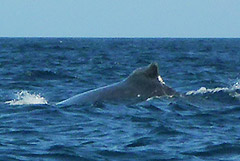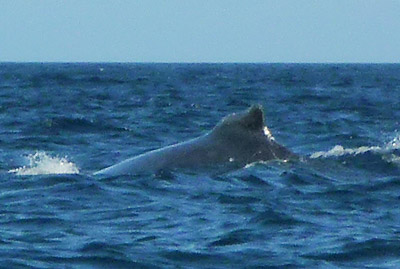Moby Dick & Whale Watching Philippines
|
Image courtesy: Jotay Resort
|
Moby Dick – the great white whale of novel and legend – you may not find here, but for sure those who voyage the waters of the Babuyan Channel, from Pagudpud to Santa Ana, Cagayan, will witness the passage of many a large Cetacea (family of whales, dolphins & porpoises) during this Winter season (January to April), including the iconic humpback whale.
Fans of the novel Moby Dick will know that it was in the vicinity of the Babuyan Islands that Capt Ahab met Capt Boomer, of the whaling ship Samuel Enderby, voyaging out of London. Capt Boomer had indirectly lost an arm to Moby Dick and had recently sighted the whale, although he was not drawn to say exactly where; instead, pressed for information by Capt Ahab, Capt Boomer questioned, “he’s best left alone; don’t you think so, Captain?”. Frustrated, Capt Ahab sailed on, North from the Babuyan Channel to Formosa (modern Taiwan) before turning southeast, towards the equator.
Moby Dick was apparently a sperm whale – a species prized for the large quantity of liquid wax (spermaceti) that could be extracted from a large cavity in its skull; spermaceti was used for lubricants and lighting, before the use of petroleum products became the norm. The legendary sperm whale was pursued by Capt Ahab from Borneo, around the West and North Philippines – through the South China Sea and the West Philippine Sea – and out into the Pacific Ocean. Listed as a vulnerable species on the ICUN Red List, sperm whales were harpooned close to extinction during the 19th and early 20th centuries, most specifically for their wax.
Today, sperm whales, Brydes whales and humpback whales can be found passing through the Babuyan Channel.
Apart from the Babuyan Channel, whales pass between the Pacific Ocean and the West Philippine Sea via the San Bernardino Strait and the Surigao Strait. From the San Bernardino Strait they can be seen passing through the Verde Island Passage, between Batangas province and Mindoro Island – in 2014 Brydes whales and a pygmy sperm whales were identified here.
Whaling In The Philippines
Records and folklore suggest the whales have been hunted in the waters of the Philippines for centuries. The subject of recent academic research, details of whaling activities in Philippine waters were recorded mostly by foreign commercial whaling fleets: by the British, 1820-1840; and, by Americans, 1825-1880. Indigenous fisherfolk did not see the need to keep records, as their purpose was almost exclusively hunting for local consumption . . . until the latter part of the 20th century, when the profit motive rose its ugly head, to satisfy increased demand for whale products from northern neighbors.
The commercial whaling industry in the Philippines was largely centred on the waters off Northern Mindanao, to the West of the Surigao Strait. The whales would swim to/from the Pacific Ocean through the Surigao Strait and pass by the islands of Camiguin and Bohol, into the Sulu Sea, especially during the period of April through June.
In 1997, a complete ban on hunting and trading in whale products was imposed and today very few whales (or dolphins or porpoises) are caught, except as by-catch during other commercial fishing activities.
Philippine Whale Watching Instead
In the aftermath of the Philippine whaling ban, fisherfolk around the islands of Camiguin and Bohol have been encouraged to transform their whale hunting skills into the creation of whale watching adventures for tourists. The increasing numbers of whales arriving in Philippine waters promises to make this tourism industry at least as valuable as the former whale hunting was. The occasional observation of a blue whale (the World’s largest mammal) in the vicinity of Pamilacan Island, South of Bohol, (first positively identified in 2004) has especially boosted interest in the area.
Whale watching tours are offered in many locations West of the Surigao Strait, most especially from the islands of Pamilacan (Panglao, Bohol), Siquijor and Negros; in my experience, the whale watching guides from Pamilacan Island offer the best value for money if whales are what you seek.
Back to Moby Dick and the Babuyan Channel: whale watching tours may be engaged from resorts in Santa Ana, Cagayan, and offer what the whale watching adventures in the South cannot . . . if you seek to view and photograph humpback whales then Pamoctan Island, from Santa Ana, is the place to be. And who knows, the great-great-grandson of Moby Dick may pass by while you are there and inspire a new novel.
Find more information about Philippines whale watching locations here:



 Humpback whale off Santa Ana, Cagayan
Humpback whale off Santa Ana, Cagayan